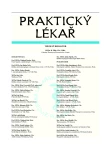Evolution and evolutionary theory for physicians. IX. Evolutionary psychology
Authors:
F. Koukolík
Authors‘ workplace:
Primář: MUDr. František Koukolík DrSc.
; Národní referenční laboratoř prionových chorob
; Fakultní Thomayerova nemocnice s poliklinikou, Praha
; Oddělení patologie a molekulární medicíny
Published in:
Prakt. Lék. 2010; 90(9): 511-514
Category:
Editorial
Overview
Evolutionary psychology attempts to explain human behavior in terms of psychological adaptations which evolved during milions of years to solve recurrent adaptive problems of our evolutionary ancestors. Examples of these problems are:
– incest taboo,
– food preference,
– ingroup interactions,
– outgroup relations,
– detection of free-riders and defectors in cooperative groups,
– different male and female strategy in struggle for mates.
There exist a number of evolutionary psychology predictions tested so far. Among limits of contemporary evolutionary psychology explanations are homosexuality, suicide and individual and cultural variability.
Key words:
evolutionary psychology, psychological adaptations, adaptive problems.
Sources
1. Buss, D.M., Duntley, J.D. The evolution of aggression. In Schaller M, Kernick DT, Simpson JA (vyd.) Evolution and social psychology. New York: Psychology Press, 2006, p. 263-285.
2. Buss, D.M. Evolutionary psychology: the new science of the mind (3rd ed). Boston: Allyn and Bacon, 2008.
3. Buss, D.M. How can evolutionary psychology successfully explain personality and individual differences? Perspect. Psychol. Sci. 2009, 4, p. 359-366.
4. Cloninger, C.R., Svrakic, D.M., Przybeck, T.R. A psychobiological model of temperament and character. Arch. Gen. Psychiatry 1993, 50, p. 975-990.
5. Confer, J.C., Easton, J.A., Fleischmann, D.S. et al. Evolutionary psychology. Controversies, questions, prospects and limitations. Am. Psychol. 2010, 65, p. 110-126.
6. Crews, D. Epigenetics, brain, behavior, and the environment. Hormones 2010, 9, p. 41-50.
7. Duntley, J.D., Buss, D.M. The origins of homicide. In J. Duntley and T. Shackelford (vyd.), Evolutionary forensic psychology. New York: Oxford University Press 2008, p. 41-64.
8. Fodor, J. The modularity of mind. Cambridge: MIT Press, 1983.
9. Franklin, T.B., Mansuy, I.M. The prevalence of epigenetic mechanisms in the regulation of cognitive function and behaviour. Curr. Opin. Neurobiol. 2010, 20, p.1-9.
10. Gong, G., He, Y, Concha, L., et al. Mapping anatomical connectivity patterns of human cerebral cortex using in vivo diffusion tensor imaging tractography. Cereb. Cortex 2009, 19, p. 524-536.
11. Haselton, M.G., Nettle, D. The paranoid optimist: An integrative evolutionary model of cognitive biases. Pers. Soc. Psychol. Rev. 2006, 10, p. 47-66.
12. Hines, M. Brain gender. New York: Oxford University Press, 2004.
13. Jackson, R.E., Cormack, L.K. Evolved navigation theory and the descent illusion. Percept. Psychophys. 2007, 69, p. 353-362.
14. Koukolík, F. Lidství. Neuronální koreláty. Praha: Galén, 2010.
15. Koukolík, F. Sociální mozek. Praha: Karolinum 2006, s. 241-266.
16. Koukolík, F. Evoluce a evoluční teorie pro lékaře. V. Darwinovy teorie evoluce. Prakt. Lék. 2010, 90 (5), s. 268-273.
17. Koukolík, F. Evoluce a evoluční teorie pro lékaře. VI. Evo – devo (evoluční vývojová biologie). Prakt. Lék. 2010, 90 (6), s. 327-332.
18. Koukolík, F. Funkční systémy lidského mozku. Praha: Galén, 2011 (v tisku).
19. Lytton, H., Romney, D.M. Parent’s differential socialization of boys and girls: a meta-analysis. Psychol. Bull. 1991, 109, p. 267-296.
20. Nairne, J.S., Pandeirada, J.N.S. Adaptive memory: Remembering with a stone-age brain. Curr. Dir. Psychol. Sci. 2008, 17, p. 239-243.
21. Nairne, J.S., Pandeirada, J.N.S., Gregory, K.J. et al. Adaptive memory: Fitness relevance and the hunter-gatherer mind. Psychol. Sci. 2009, 20, p. 740-746.
22. Nairne, J.S., Pandeirada, J.N.S., Thompson, S.R. Adaptive memory: The comparative value of survival processing. Psychol. Sci. 2008, 19, p. 176-180.
23. Neuhoff, J.G. An adaptive bias in the perception of looping auditory motion. Ecol. Psychol. 2001, 13, p. 87-110.
24. Penke, L., Denissen, J.J.A., Miller, G.F. The evolutionary genetics of personality. Eur. J. Pers. 2007, 21, p. 549-587.
25. Perilloux, C., Fleichmann, D.S., Buss, D.M. The daughter-guarding hypothesis: parental influence on children’s mating behavior. Evol. Psychol. 2008, 6, p. 217-233.
26. Pinker, S. How the mind works. New York: Norton, 1997.
27. Pinker, S. The blank slate. New York: Norton, 2002.
28. Plomin, R., Daniels, D. Why are children in the same family so different from one another? Behav. Brain. Sci. 1987, 10, p. 1-60.
29. Rose, S., Rose, H. (vyd.) Alas, poor Darwin: arguments against evolutionary psychology. Nevada City, CA: Harmony Books, 2000.
30. Silverman, L., Choi, J. Locating places. In Buss DM (Ed.) The handbook of evolutionary psychology. New York: Wiley 2005, p. 177-199.
31. Tooby, J., Cosmides, L. The psychological foundation of culture. In Barkow J., Cosmides L., Tooby L. (Eds.) The adapted mind. New York: Oxford University Press 1992, p. 19-136.
32. Tooby, J., Cosmides, L. Conceptual foundations of evolutionary psychology. In: Buss DM (vyd.) The handbook of evolutionary psychology. Hoboken, NJ: Wiley 2005, p. 5-67.
33. Wilson, E.O. Sociobiology. The new synthesis. Cambridge: Harvard University Press 1975/2000.
34. Wilson, E.O. Conscilience. The unity of knowledge. New York: Knopf, 1998.
Labels
General practitioner for children and adolescents General practitioner for adultsArticle was published in
General Practitioner

2010 Issue 9
- Memantine Eases Daily Life for Patients and Caregivers
- Metamizole vs. Tramadol in Postoperative Analgesia
- Metamizole at a Glance and in Practice – Effective Non-Opioid Analgesic for All Ages
- Memantine in Dementia Therapy – Current Findings and Possible Future Applications
- What Effect Can Be Expected from Limosilactobacillus reuteri in Mucositis and Peri-Implantitis?
Most read in this issue
- Spondylodiscitis – known and unknown
- Preoperative treatment of a diabetic patient
- Nutritional assessment of hospitalized elderly people
- Shopping addiction as a problem
